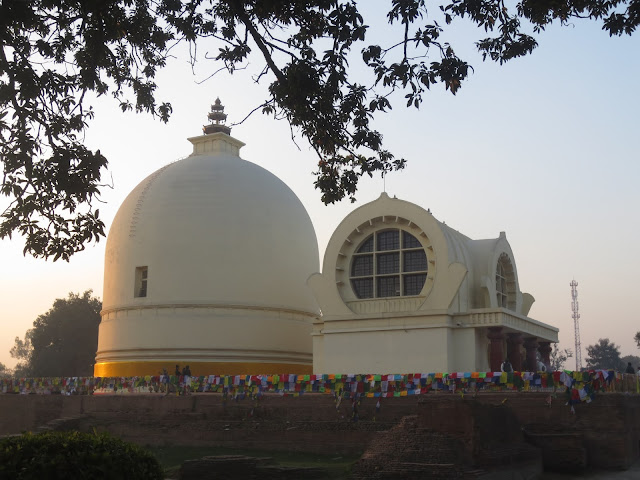The Giant Buddha of Leshan (China)
From my diary (June 2015)
Finally, the last day of
the semester. The following afternoon, I’m off to Chongqing, in the People’s
Republic of China. This time, I’m not travelling alone. Rie, my Japanese former
girlfriend (‘former’ for the best of reasons, as we were married less than two
months ago), is coming with me. I enjoy travelling on my own, but I’m happy to
be sharing this Chinese experience with my wife, whose knowledge of Chinese
will be an asset in a country where not many speak English. I had already
obtained my visa whereas Rie, thanks to her Japanese passport, did not need one
for a visit lasting less than two weeks.
The name ‘Chongqing’
might not ring a bell for many, but it’s a city with a long history. It is the
most important river port and financial and commercial centre of Southwest
China, a megalopolis of 15 million people, born at the confluence of the
Jialing River with the great Yangtze, which has its source in the Himalayas and
flows into the sea in Shanghai, 1,274 kilometres from Chongqing. We have two
main reasons for this trip: to see our friend and former colleague Milena, who
moved from the University of Malaya to Chongqing last September to start
teaching at one of the local universities; and to visit the Giant Buddha of
Leshan.
Due to a
delay with our connection at Guangzhou airport, we arrive at Milena’s very late
that night, but she is up waiting for us. The following day, we visit Ciqi Kou, a neighbourhood in Chongqing (once a village outside the city)
that has retained its ancient Qing Dynasty (1644–1911)
look.
The
next morning, after registering at the local police station (mandatory for foreigners
staying in a private household), we head for Central Station, an enormous new
building not yet complete, to catch the one o’clock fast train to Chengdu. The sheer
mass of people around us is impressive. And whereas in Europe a train may have
at the most, say, seven or eight carriages, the one we get onto must have at
least twenty. This accounts for the size of the station. Besides, everything
here must work perfectly: two trains cannot arrive at the same time on two
adjacent tracks, lest the throng be unmanageable. Every which way one looks,
one sees staff directing the crowds in the right direction. Hats off to their
perfect organisational skills.
The
train is comfortable, with a bar and restaurant service, and fast (every now
and again we touch 250 kilometres per hour). It runs for long stretches over
high viaducts, allowing us ‒ except when going through a tunnel – a view over
the urban area surrounding Chongqing and Chengdu and, between the two cities,
over the Sichuan landscape of green hills, woods, ponds and tilled land broken
here and there by the houses of small villages or farms. During the first
stretch from Chongqing, we also notice some haze in the air, apparently quite
common in this city, partly due to its geographical position and the climate
and partly, I believe, to pollution. Fortunately, we find a clearer atmosphere
in Chengdu. We arrive at Chengdu North Station in perfect time, having travelled
270 kilometres in exactly two hours.
From
the station, also vast, we decide to try and walk to the guesthouse that Milena
has booked for us, which looks fairly close on the map. The problem is, we are
not yet used to the sizes of these cities or the scale of their maps. It takes
us more than an hour to get to our guesthouse, in spite of the fact that
Chengdu is much ‘smaller’ than Chongqing – i.e. only 9 million people. Here, too, the roads are wide, forming a
regular weave with the long main streets stretching from north to south, or
circularly forming ring roads, with several flyovers to speed up the traffic. And
here, too, we notice the lanes for bicycles and motorbikes, which are electric-powered,
and the ample pavements that, unlike in Malaysia, are busy, but never so much
as to make walking difficult. Many of the buildings are relatively old, perhaps
built after the Second World War, but there are also several modern
skyscrapers, and lots of shops along the pavements.
We
finally arrive at the guesthouse, which we find unfussy but pretty, as Milena had
told us it would be. We take to it, and to the friendly and helpful young staff.
Among the services they offer is the booking of trains and suburban buses, so we
decide to book a bus to Leshan for the following morning. That done, we repair
to our room for a freshen-up and rest, on the second floor (third floor by Chinese
reckoning, where the ground floor is considered the first floor, like in the
States), overlooking a wide courtyard, one of the walls decorated with drawings
of pandas. Pandas are in fact native to this region. Just outside the city is the
Chengdu Research Base of Giant Panda Breeding, now one of the main attractions
for tourists coming to Chengdu. Even if we wanted to, unfortunately, we would
not have the time to visit it, having decided to privilege history and
spirituality before nature. But leaving something unexplored bodes well for a second
visit...
 |
| The Lingbao Pagoda |
 |
| The Dafo, the giant Buddha of Leshan |
 |
| Close-up of the Buddha |
 |
| The Buddha's feet |
 |
| The Buddha from below |







Comments
Post a Comment